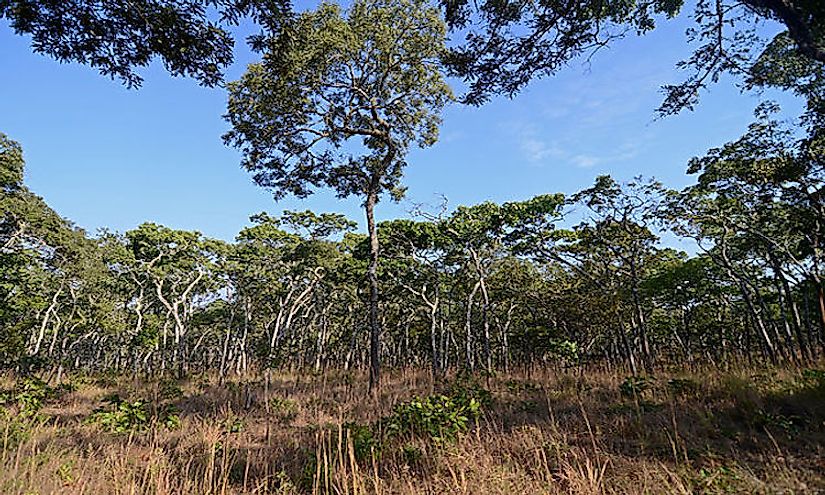Ecological Regions Of Mozambique

The tropical southeast African nation of Mozambique is home to a diverse mix of rainforests, arid grasslands, and aquatic ecosystems. Mozambique stretches covering an area of 799,380 km2 through water bodies, coastlines, plateaus, hills, and mountains. The country borders Zimbabwe, South Africa, Malawi, Tanzania, Zambia, and Swaziland, countries with which its shares ecological regions and landforms.
Ecological Regions Of Mozambique
Eastern Miombo Woodlands
The Eastern Miombo ecoregion falls under the tropical and subtropical grasslands, savannas and shrublands Biome. The ecoregion is situated in northern Mozambique and is characterized by flat-bottomed valleys, dambo wetlands, hills and undulating ridges. The rivers Rio Lurio and Rio Ruvuma traverse the landscape. The region has a seasonal tropical climate, with rainfall between November and March interrupting a long winter drought. Yearly rainfall is recorded between 800-1,400 mm, with a maximum of 1,400 mm. Miombo trees, at the height of 12-18 m, characterize the landscape and support an undergrowth of grass and shrub. The region has weathered soils which are well-drained, acidic and poor in nutrients. Notable fauna in the region includes the African elephant, impala, hippopotamus, eland, waterbuck, black rhinoceros, Burchell’s zebra, spotted hyena, lion, cheetah, African wild dog, Wildebeest and Southern reedbuck. Fires and prolonged drought seasons negatively impact on the vegetation and the animals’. Land transformation for agriculture and poaching are threats to the ecoregion, although the landscape remains largely uninhabited due to armed conflict in the country. The Nissa and Gile Game Reserves have been established in the ecoregion.
Lake Malawi
Classified in the Great Lakes Freshwater Biome is the Lake Malawi ecoregion, stretching from Mozambique to Malawi and Tanzania. At the center of this ecoregion is Lake Malawi, the world’s ninth largest lake, alongside its main Shire River outlet and other outlets. The ecoregion’s landscape includes several islands, islets, and reefs while the lake’s shoreline ranges from rocky and steep to sandy bays. Annual rainfall ranges from 600 to 2,200 mm, mostly experienced during the November to April wet season. The River supports populations of the hippopotamus, Nile crocodiles, and monkeys. Notable aquafauna species includes cichlids, catfish, Lake Sardine, African tetra and spotted killifish. The lake is also home to abundant algae, crustaceans, and mollusks. Threats to the ecoregion include oil exploration and overfishing.
Maputaland Coastal Forest Mosaic
The Maputaland Coastal Forest Mosaic ecoregion is classified in the tropical and subtropical moist broadleaf forests Biome. Located on the Southern Africa coast of the Indian Ocean, the ecoregion covers southern Mozambique. The ecoregion is characterized by dry forests, Lemombo Mountains, wetlands, swamp forests and grasslands set in a low-lying plain. The climate in the region ranges from moist tropical to subtropical, with annual rainfall recorded at 1,000 mm around the coast and under 600 mm inland. Common trees include the white witchhazel, real yellowwood, acacias, euphorbias, and aloes alongside shrubs, climbers and grass. The wetlands support populations of the Nile crocodile and other fauna such as the African elephant and forest thread snake. The ecoregion is home to the endemic neergaard’s Sunbird and the near-endemic rudd’s apalis. Although most of the region is rural, some threats are present including fires, deforestation, overgrazing, and invasive plant species. The Lubombo Transfrontier Conservation Area and the Maputo Special Reserve have protected areas in the ecoregion.
Southern African Mangroves
The Southern African Mangroves is a marine ecoregion stretching along Mozambique’s coastline. The mangroves are formed in the rivers on the Indian Ocean after the sea is warmed through the Mozambique Current. The mangroves provide crucial nesting, breeding, and migratory habitats for fauna. Marine life, crocodiles, turtles, snails and slugs, and the endangered Mangrove Kingfisher abound in the ecoregion. Being located on the coastline, the ecoregion is susceptible to pollution and sedimentation as a result of deforestation.
Other Ecological Regions In Mozambique
Mozambique’s other ecoregions are: Bight of Sofala and the Swamp Coast; China Lake; Chiuta Lake; Delagoa; East African Coral Coast; East African Mangroves; Eastern Coastal Basins; Eastern Zimbabwe Highlands; Eastern Zimbabwe montane forest-grassland mosaic; Lower Zambezi; Maputaland-Pondoland bushland and thickets; Middle Zambezi Luangwa; South Malawi montane forest-grassland mosaic; Southern Miombo woodlands; Southern Rift montane forest-grassland mosaic; Southern Zanzibar-Inhambane coastal forest mosaic; Zambezian and Mopane woodlands; Zambezian coastal flooded savanna; Zambezian flooded grasslands; Zambezian Lowveld and Zambezian highveld.
Ecological Regions Of Mozambique
| Ecological Regions of Mozambique | Biome |
| Bight of Sofala and the Swamp Coast | Marine |
| Chilwa Lake | Eastern and Coastal Freshwater |
| Chiuta Lake | Eastern and Coastal Freshwater |
| Delagoa | Marine |
| East African Coral Coast | Marine |
| East African mangroves | Mangroves |
| Eastern Coastal Basins | Eastern and Coastal Freshwater |
| Eastern Miombo woodlands | Tropical and Subtropical Grasslands, Savannas, and Shrublands |
| Eastern Zimbabwe Highlands | Zambezi Freshwater |
| Eastern Zimbabwe montane forest-grassland mosaic | Montane Grasslands and Shrublands |
| Lake Malawi | Great Lakes Freshwater |
| Lower Zambezi | Zambezi Freshwater |
| Maputaland coastal forest mosaic | Tropical and Subtropical Moist Broadleaf Forests |
| Maputaland-Pondoland bushland and thickets | Montane Grasslands and Shrublands |
| Middle Zambezi Luangwa | Zambezi Freshwater |
| South Malawi montane forest-grassland mosaic | Montane Grasslands and Shrublands |
| Southern Africa mangroves | Mangroves |
| Southern Miombo woodlands | Tropical and Subtropical Grasslands, Savannas, and Shrublands |
| Southern Rift montane forest-grassland mosaic | Montane Grasslands and Shrublands |
| Southern Zanzibar-Inhambane coastal forest mosaic | Tropical and Subtropical Moist Broadleaf Forests |
| Zambezian and Mopane woodlands | Tropical and Subtropical Grasslands, Savannas, and Shrublands |
| Zambezian coastal flooded savanna | Flooded Grasslands and Savannas |
| Zambezian flooded grasslands | Flooded Grasslands and Savannas |
| Zambezian Lowveld | Zambezi Freshwater |
| Zamebzian Highveld | Zambezi Freshwater |











